You have your heart set on a beautiful Goldendoodle. But it’s not that simple! You’ll see F1, F1B, and other varieties of Goldendoodles advertised for sale. So, what do all those letters and numbers mean? Are F1 or F1B Goldendoodles better? And which generation of Goldendoodle is the best choice for a family with allergy sufferers?
There are some significant differences between F1 and F1B Goldendoodles that you should know about before you approach a breeder to get on the waiting list for a puppy.
Read this comprehensive guide to learn the differences between an F1 and F1B Goldendoodle so that you make the right choice.
Table of Contents
What Is An F1 Teddy Bear Goldendoodle?
Let’s start by explaining what “F1” means when the term is used to describe a Teddy Bear Goldendoodle.
Meaning of F1B?
First of all, the letter “F” stands for “Filial.”
Filial simply means that the dog is a crossbreed rather than a purebred. Since every Goldendoodle is a hybrid dog that the breeder creates by crossing a Poodle with a Golden retriever, every Goldendoodle variety will have the letter “F” in its generational name.
The number “1” refers to the fact that the puppies are the first generation offspring of a Poodle and a Golden retriever.
So, What’s An F1 Goldendoodle?
An F1 Goldendoodle is basically a 50% cross between a purebred Poodle and a purebred Golden retriever. So, the puppies will carry 50% of the genes from each of the purebred parent dogs. That means that, in theory, an F1 Goldendoodle is half Poodle and half Golden retriever.
However, as with all hybrid animals, in terms of appearance and personality of every puppy will be slightly different, depending on which of the parent’s genes are dominant in that individual pup.
Of all the multigeneration Goldendoodle types, the F1 is one of the most popular. That said, there are a few downsides to this crossbreed. The main problem with any form of crossbreed dog is that each puppy will vary slightly in its physical traits and character. In other words, no two F1 Goldendoodle puppies will be exactly the same, even though they all share 50% of each parent’s genes.
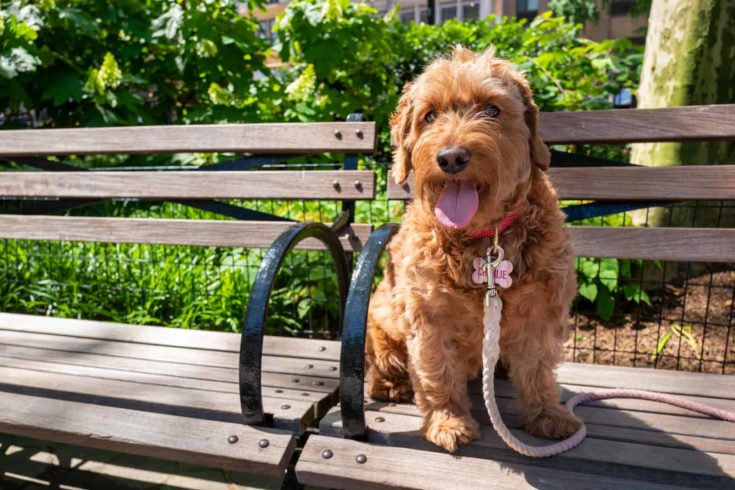
As mentioned above, even though the puppies share half of each parent dog’s genes, the makeup of each pup will depend on which of their parent’s genes are dominant. For example, you don’t know whether your puppy will have a curly, wavy, or straight coat and how hypoallergenic the adult will be. Also, you don’t know what the puppy’s coat color will be until the youngster is fully grown.
Dominant Poodle genes cause the coat to be curly or wavy. Since purebred Poodles don’t shed, an F1 Goldendoodle puppy that takes mostly after the Poodle parent will be more hypoallergenic than one that has more dominant Golden retriever genes. When it comes to personality traits, Golden retrievers are generally regarded as being very loving and loyal, whereas Poodles are more intelligent.
What Is Hybrid Vigor?
One of the most beneficial aspects of F1 Goldendoodles is that all puppies of that generation have what’s called Hybrid Vigor.
Hybrid Vigor essentially means that crossbreed dogs are usually healthier than purebreds.
How so?
Well, when purebred dogs are continually inbred to maintain the purity of the genetic line, the same hereditary defects are carried right down the line to the offspring. So, serious physical problems, such as hip dysplasia and PRA (Progressive Retinal Atrophy), are common.
However, in F1 Goldendoodles, only genetic defects that are found in both the Poodle and Golden retriever can be passed down to the puppies. To ensure that doesn’t happen, reputable and responsible breeders only use health-screened stud dogs that are proven to be free from such hereditary conditions. Ideally, a breeder will be able to prove that their stud dogs’ parents and grandparents also had clear health screening tests.
What Does F1B Mean?
Now that you understand what an F1 Goldendoodle is, let’s find out what F1B means.
So, as you might expect, F1B means essentially the same as F1, but with the addition of the letter “B.” “B” stands for Backcross. Backcross means that the F1 dog is bred with a purebred parent breed.
So, “F” still means filial, meaning that the dog is a crossbreed, and figure “1” indicates that the animal is a first-generation puppy from a Golden retriever and a Poodle.
What Is An F1B Goldendoodle?
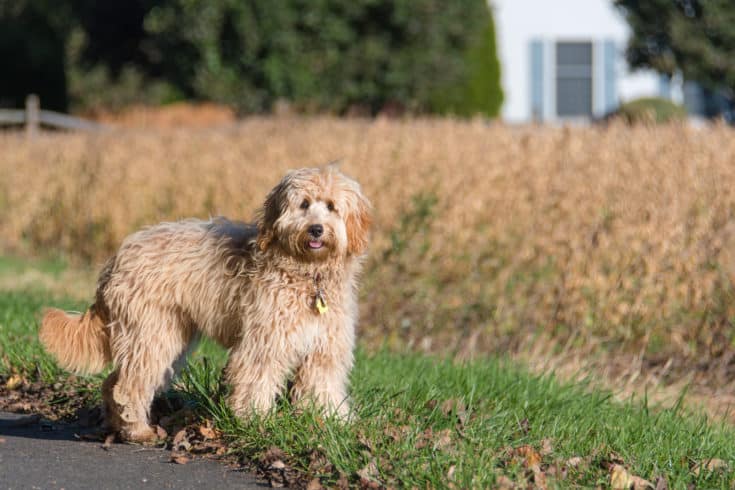
An F1B Goldendoodle is the offspring of an F1 Goldendoodle backcrossed with either a purebred Golden retriever or a purebred Poodle. That means an F1B Goldendoodle puppy is 75% Poodle and 25% Golden retriever.
Goldendoodle breeders typically breed an F1 Goldendoodle with a purebred Poodle to produce puppies that are light-shedding and more hypoallergenic than they would be if a purebred Golden retriever was used. So, if you breed an F1 Goldendoodle, which is 50% Golden retriever and 50% Poodle, with a purebred Poodle, you end up with an F1B Goldendoodle that’s 75% Poodle and 25% Golden retriever.
Non-Shedding
F1B Goldendoodles are more popular with both breeders and potential owners because these dogs tend not to shed as much and are more hypoallergenic than F1 Goldendoodles.
That’s because an F1B Goldendoodle is 75% Poodle, so the dog is far more likely to have a curly or wavy coat that hardly sheds and is, therefore, extremely hypoallergenic. For that reason, many dog owners, especially those with severe allergies, always choose an F1B over an F1 Goldendoodle. Also, an F1B dog with tighter curls means you won’t have the problem of dog hair all over your clothes, furniture, and floors, which is great news for you if you hate your vacuum cleaner!
However …
Unfortunately, there is a downside to the F1B Goldendoodle in terms of the Hybrid Vigor trait we discussed above.
Because the F1B is classified as a second-generation crossbreed dog, they generally inherit less Hybrid Vigor and the health benefits that the trait brings. As the generation number of the Goldendoodle increases, the less Hybrid Vigor trait is inherited, and so the likelihood of the puppies inheriting congenital health diseases is greater.
F1 vs. F1B Goldendoodle
As you can see, there are a few notable differences between F1 and F1B Goldendoodles when the two breeds are directly compared side-by-side:
Features
F1 Goldendoodle
F1B Goldendoodle
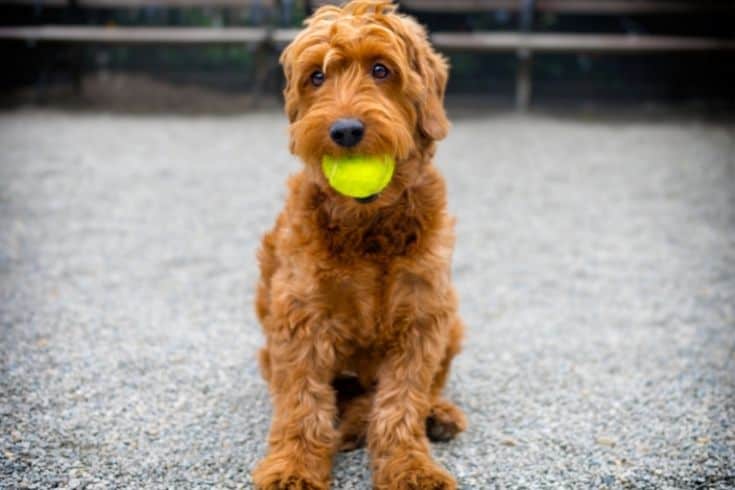
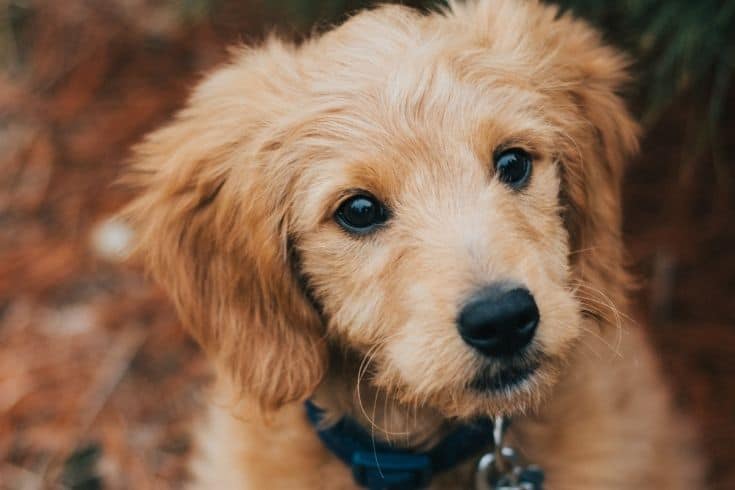
Coat Type
Straight, wavy, curly
Wavy, curly
Hypoallergenic
Variable, depending on the puppy’s genetic makeup
Yes, generally
Shedding
Moderate
Light to very light
Hybrid Vigor
Yes
Moderate
Intelligence
Moderately intelligent but eager to please
Highly intelligent and very trainable
Personality
Loving and loyal
Loving and loyal but somewhat less so than the F1 Doodle
F1 Goldendoodle

Coat Type
Straight, wavy, curly
Coat color:
Black, golden, chocolate, blonde, cream, apricot, red
Hypoallergenic
Variable, depending on the puppy’s genetic makeup
Shedding:
Depends on coat length
Hybrid Vigor
Yes
Intelligence:
Moderately intelligent but eager to please
Personality
Loving and loyal
F1B Goldendoodle

Coat Type
Wavy, curly
Hypoallergenic
Yes, generally
Shedding
Light to very light
Hybrid Vigor
Moderate
Intelligence
Highly intelligent and very trainable
Personality:
Loving and loyal but somewhat less so than the F1 Doodle
So, most people choose an F1B Goldendoodle over an F1 Goldendoodle since they want a pet that sheds less. However, it’s important to remember that a Goldendoodle with a wavy or very curly coat will need much more grooming and brushing than a straight-coated type, as those tight Teddy Bear curls do tend to tangle and form mats. As well as a daily brush, an F1B Doodle will need clipping every month or so to keep the coat in tidy, mat-free condition.
On the upside, an F1 Goldendoodle will have more Hybrid Vigor traits than an F1B dog, so it ,is less likely to inherit serious health conditions. Remember that Hybrid Vigor means that your F1 Goldendoodle will most likely be much more hardy and longer-lived than either the purebred Poodle or Golden retriever parent dogs.
Frequently Asked Questions
Now, here are the answers to some of the most commonly asked questions about F1 vs. F1B Goldendoodles.
Q: Are F1 or F1B Goldendoodles more expensive?
A: A first-generation F1 Goldendoodle is usually priced at around $2,000, depending on the size, color, and parent dogs’ breeding. These dogs are generally cheaper than F1B Goldendoodles because they are considered to be easier to breed than other generations. Also, demand for F1 dogs is less than it is for multi-generation crosses that are lighter shedders.
F1B Goldendoodles are slightly more expensive. That’s because of their desirable non-shedding and hypoallergenic qualities.
Q: Which is better for allergy sufferers – The F1 Or F1B Goldendoodle?
A: F1B Goldendoodles are 75% Poodle. Therefore, they tend to have curly coats that don’t shed as much as F1 Goldendoodles that are 50% Golden retriever. So, mild allergy sufferers generally do better with an F1B Doodle than an F1.
Q: Which is the calmest Doodle – F1 or F1B?
A: There’s really no difference between the two! When it comes to exuberance, all Goldendoodles are lively, playful dogs. A Goldendoodle is not the best choice of furry friend for you if you want a couch potato.
Doodles fare best when part of an outdoorsy family that loves to spend time hiking or enjoying other activities in the Great Outdoors. A lack of exercise and mental stimulation can result in boredom and frustration, which often manifests itself in excessive barking or destructive behaviors. So, you must make the time to exercise and entertain your Goldendoodle every day!
Q: What is the smartest Goldendoodle – F1 or F1B?
A: Although there are exceptions to every rule, the F1B Goldendoodle is generally the smartest of the two breeds. That’s because Poodles are regarded as highly intelligent, whereas Golden Retrievers are known to be more loving and loyal than super-bright. That said, both F1B and F1 Goldendoodles are highly trainable dogs that love to please their owners.
Q: Do F1 Goldendoodles shed?
A: Contrary to popular belief, F1 Goldendoodles are not zero shedders. Thanks to their straight hair, F1 dogs do shed, but not as much as many other dog breeds. The degree of shedding depends on how much of the Poodle parent’s genes each puppy inherits. Generally, the curlier hair the puppy has, the less it will shed as an adult.
F1 Goldendoodles are double-coated dogs. That means that they have a fluffy undercoat and a top guard coat of long, coarse hair that doesn’t shed. The fluffy undercoat is shed in spring and fall to make way for a new one as the dog’s body prepares for the new season. Shedding is usually triggered by the increase or decrease in daylight hours and temperature changes.
However, provided that you brush your dog every day, shedding should be minimal.
Q: Are F1B Goldendoodles healthy dogs?
A: Yes, provided they are well-cared for, F1B Goldendoodles are generally healthy dogs.
Thanks to the Hybrid Vigor rule, F1B Goldendoodles are often healthier than their purebred parents. So, you shouldn’t need to worry about the expensive health complications that can affect purebred dogs.
Also, crossbreed dogs tend to live longer than their purebred cousins, so you’ll get to enjoy spending even more years with your furry friend. In fact, a Goldendoodle’s average lifespan is around 15 years, compared with that of a Golden retriever’s life expectancy of just ten to 12 years.
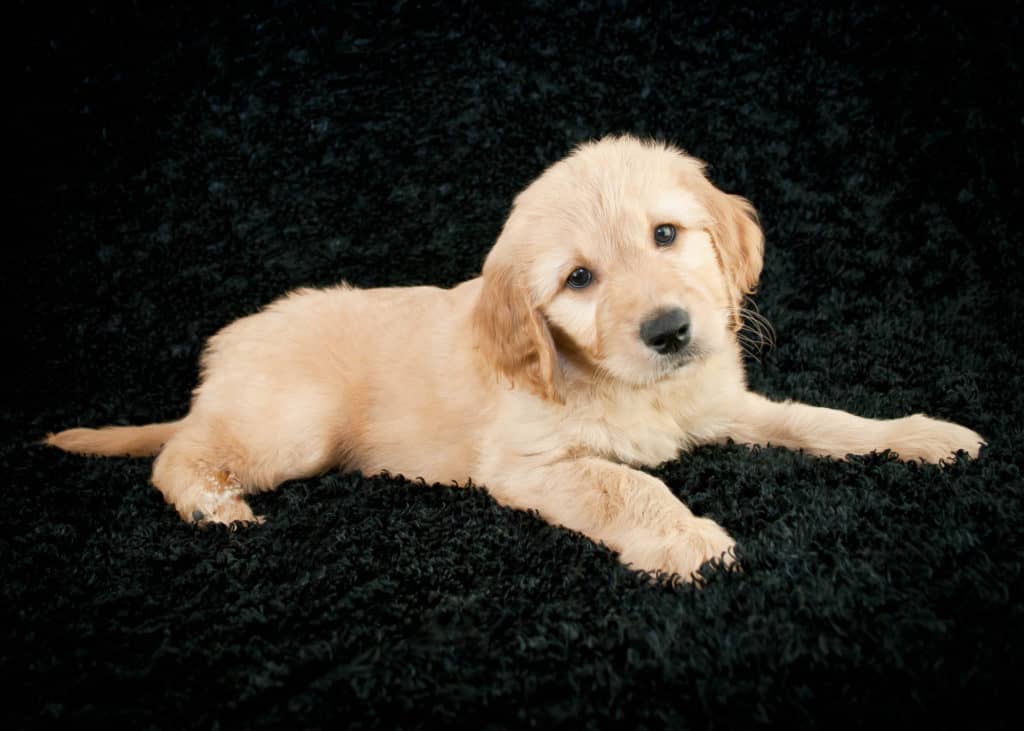
That being said, F1B Goldendoodles are second-generation backcrossed dogs, so they do lose some Hybrid Vigor benefits. So, although that shouldn’t affect your dog’s health too much, I advise you to keep up with regular routine veterinary health checks for your pet, especially as your pet gets older.
To keep your F1B Doodle fit and well, make sure that he gets plenty of exercise in the form of walks, interactive games with you in your backyard, and training sessions. You also need to feed your Goldendoodle a high-quality, balanced diet.
There is a chance that your Goldendoodle could suffer from certain health problems, including hip dysplasia, eye diseases, heart problems, and skin conditions at some point during their life. However, if you buy your puppy from a reputable breeder whose stud dogs are properly health-screened, those conditions shouldn’t affect your dog.
Q: Is my F1 Goldendoodle hypoallergenic?
A: If you’re an allergy sufferer, an F1 Goldendoodle might not be the best choice of canine companion for you, as they do shed somewhat and they are not as hypoallergenic as F1B Doodles. On the upside, F1 Goldendoodles don’t require as frequent grooming as curlier coated types.
Q: Are F1B Goldendoodles good family dogs?
A: Absolutely! All Goldendoodles make excellent family dogs. F1B Goldendoodles are highly intelligent, trainable dogs and they can be very loving, too. Usually, a well-socialized F1B Goldendoodle gets along well with other pets and with children.
These dogs can become so attached to their human family that they tend to suffer from separation anxiety sometimes. That can lead to behavioral problems, including barking and the destruction of furniture and other items in the home.
Q: Are F1 or F1B Goldendoodles better?
A: That’s the all-important question you’ll be asking as a potential dog owner if you’re considering getting a Goldendoodle as a family pet. Well, these are both fantastic dogs that make wonderful family pets. But to make the best choice for your circumstances, you’ll need to consider what you want from a canine family member.
For example, if you have pet allergy sufferers in your household, you should go with the F1B Goldendoodle, as they don’t generally shed as much and are regarded as more hypoallergenic than the F1 Doodle. That means that your allergies won’t get triggered as severely by your furry friend.
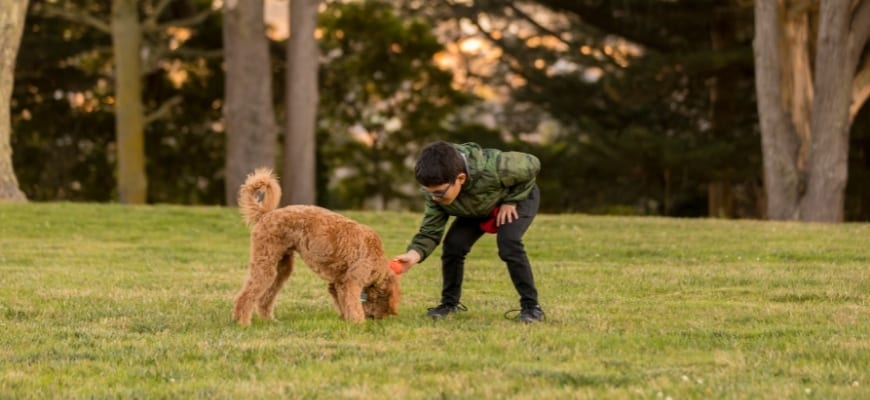
However, as F1B Goldendoodles are so popular for their hypoallergenic qualities, you can expect to pay more for one of these pups, which could be a consideration if you’re on a budget. Also, the F1B’s curly, low-shedding coat does take more grooming and brushing to keep it mat-free than a straighter coated F1 Doodle’s silky locks.
So, if you don’t have the time to spend brushing your dog every day, and you don’t want the hassle and expense of taking your pet to the groomer’s salon every few weeks, an F1B might not be the best choice for you.
If you want a loving, cuddly dog that wants to please you and doesn’t need as much brushing and grooming as an F1B, then an F1 Goldendoodle could be the way to go.
Q: Can you breed an F1 Goldendoodle with an F1B Goldendoodle?
Yes, you can. If you breed an F1 Goldendoodle with an F1B Goldendoodle, you get an F2B Goldendoodle. These third generation offspring are commonly referred to as multi-generation Goldendoodles.
An F2B Goldendoodle carries 62.5% Poodle and 37.5% Golden retriever genes. Some breeders breed an F1B Goldendoodle with another F1B Goldendoodle, producing an F2B dog that carries 75% Poodle and 25% Golden retriever genes.
Thanks to the large percentage of Poodle genes in an F2B Goldendoodle, the puppies usually have very curly coats and are very light shedders, making them more hypoallergenic. That said, since the dogs are hybrids, there are sure to be exceptions to that rule. That’s what makes owning a Goldendoodle so exciting – you don’t know exactly how your puppy will turn out until he grows up!
In Conclusion
I hope you enjoyed our comparison of F1 and F1B Goldendoodles and found the information helpful. Please share the article if you loved it!
F1 and F1B Goldendoodles have notable differences when it comes to personality and physical attributes. Since both breeds are essentially hybrid dogs, their genetic makeup varies from puppy to puppy, depending on which parent dog’s genes are dominant in each of their offspring. That means that the color, size, and personality of the puppies can’t be accurately predicted.
Generally, F1 Goldendoodles tend to have straighter coats that shed more, so these dogs aren’t considered to be hypoallergenic but are the better choice if ease of grooming is important to you. F1B Doodles, however, are 75% Poodle, so their coats are usually wavy or very curly and they shed very little. Both breeds are friendly, sociable, and make wonderful family pets. However, the F1B crossbreed is considered to be more intelligent and trainable than the F1 Goldendoodle that’s typically more loving and loyal.
What generation of Doodle did you choose? Tell us in the comments box below.
Excellent article. We have N F1B. She is very laid back and doesn’t shed. Somewhat stubborn. The joy of our lives.
I raise both and own both. What a joy I have in my life
I have a delightful 4yr old mini F1 female. She certainly is a lover, wants to hang out with me 24/7. She is also very smart and eager to please. Best dog I have ever owned..
I have an f1 golden doodle- she is beautiful andsmart and does not shed.she looks more like her mother a white golden retriever.
Sheiks wavy and silky.
Since I had a trauma she has saved my soul.
Like Velcro and I could not be happier.
Very loving…